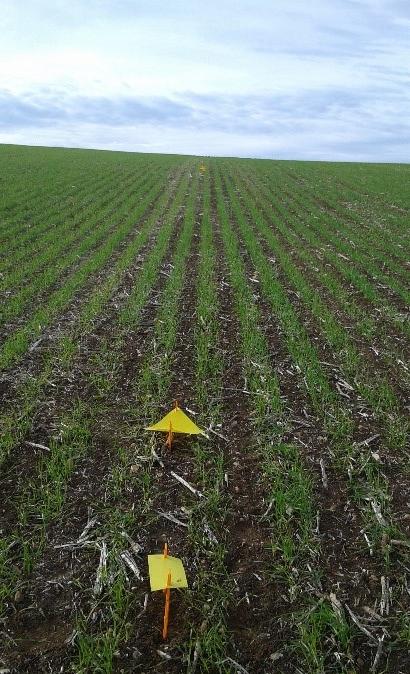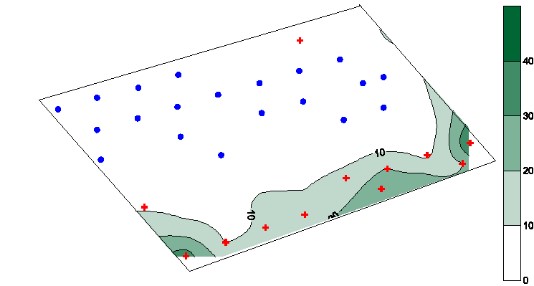Combining sticky traps & technology to monitor cereal aphids & predict BYDV risk
This year will be the first that neonicotinoid seed dressings will no longer be routinely applied to cereal crops following their ban last year. This no doubt will be making many farmers rather nervous and reaching for a few cans of pyrethroid. Unfortunately, resistance to these products by the aphids is on the increase and will ultimately make them useless unless they are used prudently. Moreover, these insecticides are also toxic to the beneficial insects that can help control aphids, especially the tiny money spiders, beetles and parasitic wasps that are active in the autumn. The products are also highly toxic to aquatic insects if they get into water, and with insect armageddon upon us, they all need a helping hand.
Since last September GWCT and Agrii have been testing whether sticky traps could be used as a monitoring tool to predict the levels of aphids invading fields and when in a pilot project funded by AHDB. At its simplest, the sticky traps can be used in conjunction with the AHDB or Agrii BYDV Alert tools to indicate when aphids are arriving and so act as the trigger to start these tools. These then calculate the number of day degrees (using weather data) until a foliar spray should be applied to halt the secondary spread of aphids, the ones most likely to spread BYDV across the field. A more advanced approach would be to develop a spray threshold, perhaps in conjunction with a decision support system app. This second approach was beyond the scope of the current pilot study.

A previous GWCT study found that invading cereal aphids were much higher in the headland areas of the field and declined towards the centre. To confirm this, we deployed sticky traps in over 60 fields, with traps at 5m and 70m from the crop edge. Overall three and half times as many aphids were caught on the traps 5m from the edge compared to 70m, and in only 9 fields were they higher at 70m. To look at this in more detail we also set up traps in a grid system at 40m intervals across two fields. This again confirmed that most aphids were located around the edges and in the areas of the fields closest to the prevailing wind (see below). This could be expected as it is known that air currents flowing over boundary features then dip down into the field, and aphids, being weak flyers, are carried on these currents. This offers the possibility of only spraying the headlands, but with LERAPS and the potential for drift into the field boundaries which are important overwintering sites for many insects and spiders, practically this poses some problems.

Trial examining spatial distribution of cereal aphids within a field, red crosses are aphid patches and blue circles are gaps without aphids
We also found that there was huge variation in the levels of aphids invading each field and this even differed between fields on the same farm. No aphids were captured in approximately 20% of the fields in November, with most having relatively low levels. Such variation suggests that a field or farm-based monitoring system could help reduce insecticide usage.
The levels of aphids alone is not the only important factor effecting whether BYDV will occur and the proportion infected with BYDV. For an MSc project, aphids were tested for virus presence in two of the fields with the highest numbers, however in one, no infected aphids were found, whilst the other had 5% infected. This result is similar to other studies. Unfortunately the process of virus testing is quite complex and costly at present so cannot currently be used as a decision support tool.
We also trialled the sticky trap system with farmers and agronomist for ease of use and to see if they could accurately identify aphids. We gave them a very simple identification guide as we wanted to evaluate whether they could identify aphids with the most basic training. They liked the sticky trap approach, however, they often either missed aphids or misidentified them and so a better identification guide is needed with high quality pictures or even a video. They recognised the need for field-specific monitoring and would be willing to use them in at least 4-5 fields on their farm.
In the project we were also hoping to explore the use of a French infestation threshold of 3 aphids per plant to predict spray timings in a trial set up by Agrii using untreated seed. However, unfortunately the aphids failed to co-operate with very few infesting the plots, so that the threshold could not be tested. Two of the treatments were treated with insecticide which reduced BYDV damage to 0.25% compared to 4.9% when unsprayed, this translated into a significant yield gain of 0.51 tonnes per hectare.
Analyses are still underway and we will explore to what extent the type of tillage effected levels of immigrating aphids. When aphids are in the air they have some ability to direct their landing place and the presence of crop debris may help disguise the presence of the crop. Once in the crop, minimum tillage and debris can also encourage natural enemies that can prevent them establishing. Previous GWCT research has shown that some natural enemies are damaged by intensive tillage whilst crop debris offers a more diverse architecture on which spiders can spin their webs. We also look at the extent to which the surrounding landscape effects the numbers of aphids dispersing across the landscape.
To reduce the risk of BYDV this year, there are some options available. Aphids can survive between crops if there is a green-bridge; annual meadow grass in particular can harbour aphids. Removing this before cultivating will help. The evidence that minimum tillage will reduce aphids isn’t yet clear, but we know from other studies that intensive tillage practices can damage populations of ground-living beneficial insects. Drill later and thereby the risk of aphids infesting and spreading before cold weather halts their progress. Finally, if you have to use pyrethroids follow the guidelines for resistance management. Only grain aphids have developed resistance so far, but this was the predominant species in our studies that covered southern and eastern England and the Midlands. Bird-cherry oat aphids are considerably more important in south-west England (see IRAG publications)
The AHDB project 21120077 Field monitoring of BYDV risk in winter cereals (pilot study) is run by GWCT and Agrii with in-kind funding from Agrii and BASF.


John Holland write of himself: “I am Head of Farmland Ecology at the Game and Wildlife Conservation Trust. After studying Horticulture at Reading in the early 1980s, I worked on a farm for a year and then decided to go into research starting with a MSc in Integrated Pest Management at Southampton University followed by a PhD in New Zealand where I investigated why spider mite resurgence occurred following pyrethroid insecticides. I joined the Game Conservancy Trust in 1992 to work on an Integrated Farming Systems project and when that completed in 1998 became Head of Entomology. Since then I have worked mostly on large collaborative projects that have involved investigating the ecology of insects on farmland with the aim of understanding the impacts of farming practices or to develop techniques to enhance their numbers. I coordinated the QUESSA EU FP7 project that quantified the impact of semi-natural habitats on key ecosystem services such as pest control and pollination. I am currently leading an INTERREG project called BEESPOKE that aims to increase crop yields through enhancing levels of pollinators. I have an honorary professorship at University of Sussex and have authored or co-authored more than 130 scientific publications, including 80 in peer reviewed journals.”
Header image: Metopolophium cf. dirhodum – alate on bulrush, S. Rae CC BY 2.0

